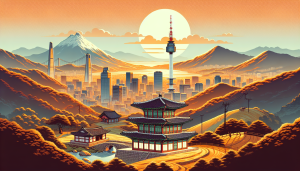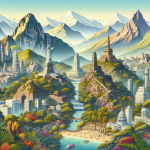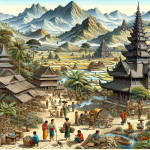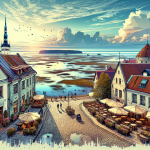Discovering the Rich Tapestry of South Korea: A Journey Through Tradition and Modernity
South Korea, a country where ancient traditions seamlessly blend with cutting-edge technology, offers a myriad of experiences for every type of traveler. This East Asian gem, known for its vibrant culture, delectable cuisine, and breathtaking landscapes, has something for everyone. From the bustling streets of Seoul to the serene temples in the countryside, South Korea is a land of contrasts that promises to captivate your senses and leave you with unforgettable memories. In this comprehensive guide, we will delve deep into the rich tapestry of South Korea, exploring its historical sites, natural wonders, and modern marvels. Whether you’re a history buff, a nature enthusiast, or a tech-savvy traveler, South Korea has plenty to offer. So pack your bags and get ready to embark on a journey through one of Asia’s most dynamic and intriguing destinations.
Exploring Seoul: The Heartbeat of South Korea
Seoul, the capital city of South Korea, is a bustling metropolis where the past and present coexist harmoniously. As one of the most technologically advanced cities in the world, Seoul is a hub of innovation and culture.
Historical Landmarks
Gyeongbokgung Palace: Constructed in 1395, Gyeongbokgung Palace is a testament to South Korea’s royal heritage. Visitors can witness the changing of the guard ceremony and explore the palace’s expansive grounds.
Bukchon Hanok Village: This traditional village offers a glimpse into Korea’s past with its well-preserved hanoks (traditional Korean houses). Strolling through the narrow alleyways, you can experience the charm of old Seoul.
Modern Marvels
Dongdaemun Design Plaza (DDP): Designed by the renowned architect Zaha Hadid, DDP is a futuristic building that hosts exhibitions, fashion shows, and cultural events. Its unique design makes it a must-visit for architecture enthusiasts.
Lotte World Tower: Standing at 555 meters, Lotte World Tower is the tallest building in South Korea. The tower offers stunning panoramic views of Seoul from its observation deck, as well as luxury shopping and dining options.
The Serenity of South Korea’s Countryside
Beyond the urban sprawl of Seoul, South Korea’s countryside offers a stark contrast with its serene landscapes and traditional villages.
Jeju Island: The Hawaii of South Korea
Often referred to as the “Hawaii of South Korea,” Jeju Island is a volcanic island known for its natural beauty and unique cultural heritage.
Hallasan National Park: Home to the highest mountain in South Korea, Hallasan National Park offers excellent hiking opportunities. The park’s diverse flora and fauna make it a haven for nature lovers.
Seongsan Ilchulbong (Sunrise Peak): This UNESCO World Heritage Site is a tuff cone crater formed by volcanic eruptions. Climbing to the top offers breathtaking views of the island and the surrounding ocean.
Andong: A Glimpse into Traditional Korea
Andong is a city steeped in history and tradition, offering visitors a chance to experience Korea’s cultural heritage.
Hahoe Folk Village: This UNESCO World Heritage Site is a well-preserved traditional village where visitors can see traditional Korean houses and watch folk performances.
Andong Mask Dance Festival: Held annually, this festival celebrates Korea’s traditional mask dance, or talchum. The vibrant performances and colorful masks provide a fascinating insight into Korean culture.
South Korea’s Culinary Delights
No trip to South Korea is complete without indulging in its culinary delights. Korean cuisine is known for its bold flavors, diverse ingredients, and unique preparation methods.
Street Food in Seoul
Seoul’s street food scene is a gastronomic adventure in itself. From savory snacks to sweet treats, the city’s night markets offer a wide array of mouth-watering options.
Tteokbokki: These spicy rice cakes are a popular street food item, known for their chewy texture and fiery sauce.
Hotteok: These sweet pancakes filled with brown sugar, honey, and nuts are a must-try for anyone with a sweet tooth.
Traditional Korean Dishes
Kimchi: This fermented vegetable dish is a staple in Korean cuisine. Made from cabbage, radishes, and a variety of seasonings, kimchi is known for its tangy flavor and health benefits.
Bibimbap: A colorful and nutritious dish, bibimbap consists of rice topped with an assortment of vegetables, meat, and a fried egg, all mixed together with gochujang (Korean chili paste).
South Korea’s Festivals and Events
South Korea’s calendar is packed with festivals and events that celebrate its rich culture and heritage. These events offer a unique opportunity to experience the country’s traditions and customs.
Cherry Blossom Festivals
Jinhae Gunhangje Festival: Held in the city of Jinhae, this festival is one of the largest cherry blossom festivals in South Korea. The city is transformed into a pink paradise, attracting visitors from all over the world.
Yeouido Spring Flower Festival: Located in Seoul, this festival takes place along the Han River, where cherry blossom trees line the streets, creating a picturesque setting.
Lantern Festivals
Seoul Lantern Festival: Held annually in November, this festival features stunning lantern displays along the Cheonggyecheon Stream in downtown Seoul. The intricate designs and vibrant colors make it a visual feast.
Lotus Lantern Festival: Celebrated in honor of Buddha’s birthday, this festival includes a grand parade of lanterns, traditional performances, and various cultural activities.
The Technological Wonders of South Korea
South Korea is at the forefront of technological innovation, and its cities are a testament to its advancements.
Smart Cities
Songdo International Business District: Songdo is a smart city built from scratch, incorporating cutting-edge technology and sustainable practices. It serves as a model for future urban development.
Sejong City: As the administrative capital of South Korea, Sejong City is designed with smart infrastructure and green spaces, promoting a high quality of life for its residents.
Tech Hubs
Gangnam District: Known for its upscale lifestyle, Gangnam is also a tech hub with numerous startups and tech companies. The district is a hotspot for innovation and entrepreneurship.
Pangyo Techno Valley: Often referred to as South Korea’s Silicon Valley, Pangyo Techno Valley is home to many leading tech companies and research institutions.
South Korea’s Natural Wonders
South Korea’s diverse landscapes offer a wealth of natural beauty, from mountains and forests to rivers and beaches.
National Parks
Seoraksan National Park: Located in the northeastern part of the country, Seoraksan National Park is renowned for its stunning mountain scenery, hiking trails, and diverse wildlife.
Jirisan National Park: As the largest national park in South Korea, Jirisan offers rugged terrain, ancient temples, and picturesque valleys.
Coastal Beauty
Busan’s Haeundae Beach: One of the most famous beaches in South Korea, Haeundae Beach in Busan is a popular destination for sunbathing, swimming, and beach festivals.
Jeju’s Hamdeok Beach: Known for its clear blue waters and white sandy shores, Hamdeok Beach is a perfect spot for a relaxing day by the sea.
Practical Tips for Traveling in South Korea
To make the most of your trip to South Korea, it’s essential to be well-prepared and informed.
Getting Around
Public Transportation: South Korea has an extensive and efficient public transportation system, including subways, buses, and high-speed trains. The T-money card is a convenient way to pay for transportation.
Taxis: Taxis are readily available in cities and are a convenient way to get around, especially for short distances.
Language and Communication
Language: While Korean is the official language, many signs and information are available in English, especially in tourist areas. Learning a few basic Korean phrases can be helpful.
Internet and Connectivity: South Korea has one of the fastest internet speeds in the world. Free Wi-Fi is widely available in public places, and portable Wi-Fi devices can be rented for convenience.
Cultural Etiquette
Respecting Traditions: South Korea has a rich cultural heritage, and it’s important to respect local customs and traditions. For example, bowing is a common way to greet others, and removing shoes before entering a home is customary.
Dining Etiquette: When dining in South Korea, it’s polite to wait for the eldest person to start eating before you begin. Using both hands when giving or receiving something is also considered respectful.
Conclusion
In conclusion, South Korea is a destination that offers a unique blend of tradition and modernity. Whether you’re exploring the vibrant streets of Seoul, hiking through the serene landscapes of Jeju Island, or indulging in the country’s culinary delights, there’s no shortage of experiences waiting for you. The country’s rich cultural heritage, coupled with its technological advancements, makes it a fascinating place to visit. So if you’re looking for a travel destination that offers something for everyone, South Korea should be at the top of your list. Plan your trip today and get ready to discover the rich tapestry of this incredible country. For more travel tips and guides, visit Travel and Leisure.








